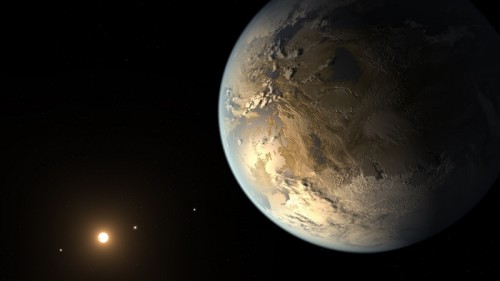
Artist’s illustration of Kepler-186f. (Courtesy: NASA/SETI Institute/JPL-Caltech)
By Tushna Commissariat
Early last week, astronomers announced that they had found the first Earth-sized exoplanet that is comfortably within the habitable zone of its parent star, using NASA’s Kepler telescope. The new planet, dubbed Kepler-186f, is a close cousin of the Earth as it has a radius that is only 10% larger than that of the Earth, meaning that it could have liquid water on its surface, allowing for the tantalizing possibility of some form of life to exist upon it. At last count, Kepler has now discovered and confirmed 1706 exoplanets.
So it was rather interesting to come across two stories that looked at the implications of life beyond our planetary neighbourhood. Paul Gilster, who writes the Centauri Dreams blog had a rather interesting post on how artists and illustrators need to work with scientists to depict each new exoplanet, to make the images look visually stunning, while still being scientifically accurate. Gilster also talks specifically about the image (see above) that illustrates the newly found Kepler-186f.
The New Yorker’s science writer David Berreby instead ponders upon what exactly would constitute “intelligence” when it comes to a form of alien life that may be discovered. He talks about how it is easy to think of aliens that mimic humans in every way and looks at the merits of changing our perceptions and criteria for what makes up a measure of intelligence.
And once you have considered that deep and complex question, take a look at what may possibly be one of the earliest papers published on the notion of space–time and the ability to manipulate it. John Ptak, who writes the Ptak Science Books blog, came across a 1885 Nature paper that he says is “the most probable source for H G Wells’ earliest inspirational source for thinking that would result in such classics as The Time Machine”.
On a lighter note, in this amusing and informative article on the Wired website titled “Galileo got game: 5 things you didn’t know about the physics of basketball”, physicist and writer Aatish Bhatia takes a deeper look at some of the common moves that are used by basketball players, as well as explaining why sometimes a basketball is lighter than it is!
For some weekend browsing take a look at a new report that suggests physicists seem to be the most hard-working when it comes to research and teaching and see how to be an astrotourist in Chile. And then for some adventure, take a look at this new real-time Google Maps app called “HerdTracker” that follows the migration of wildebeest across the Serengeti and Masai Mara regions.
Guidelines
Show/hide formatting guidelines
this text was deletedwhere people live in harmony with nature and animals</q>
Some text